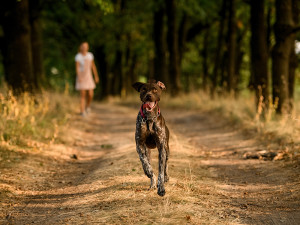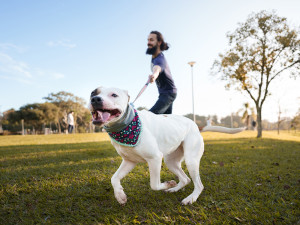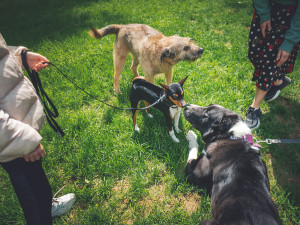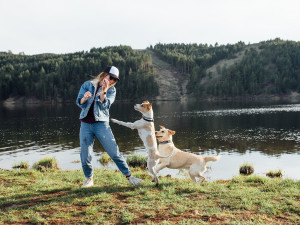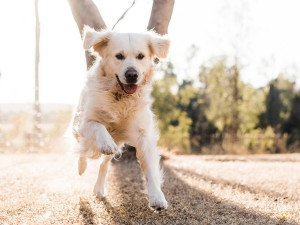How Can You Stop Your Dog From Being Overly Protective of You?
Dog trainer Robert Haussmann’s tips for dealing with a protective dog that’s taken their duties too far.
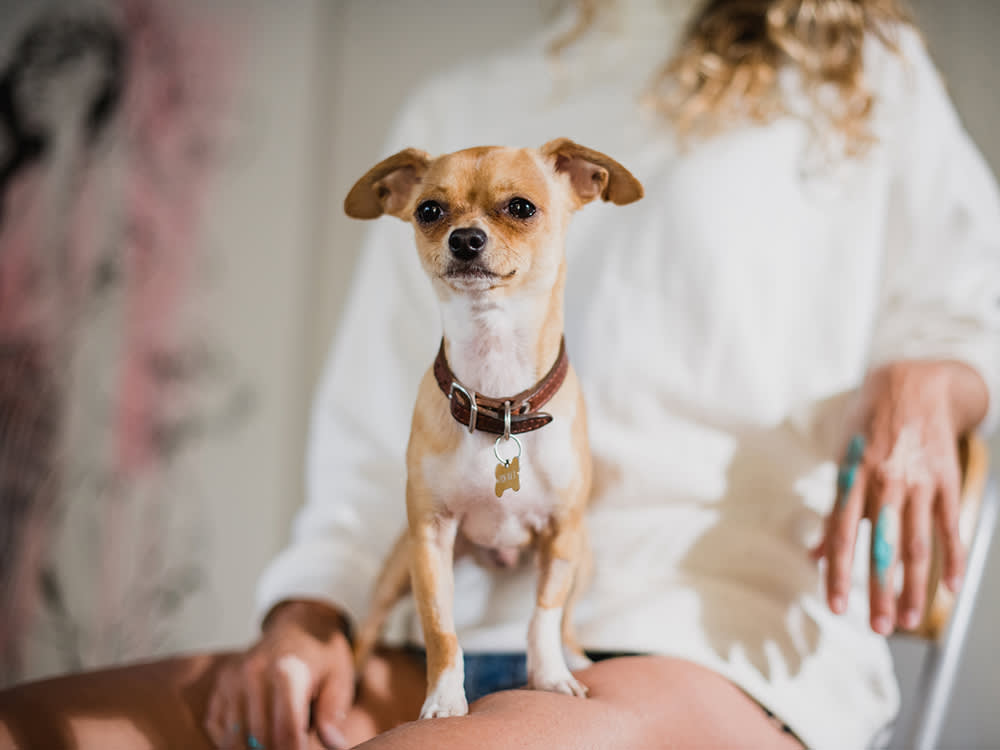
Share Article
My dog, Covid, is very protective of me, which is good to an extent. But he won’t even allow my 16-year-old and 20-year-old kids to hug me without getting defensive toward them. I’m not sure if he is just intimidating them or if he will really attack them, but I don’t want to find out. What can I do to prevent this from happening? - Amanda
This is a scary problem to have, especially when kids are involved. The truth is, it’s also a hard question to give a straightforward answer to. A lot depends on your dog’s motivation. Is your dog protecting you? Is he resource guarding? Is he in fear of the kids? Observe your dog’s body language while going toward your kids — is he barking and growling? Is his hair standing on end?
In general, focus on utilizing a “stay” cue in this case, ideally through a barrier like a baby gate — but not something as obstructing as, say, a tall fence. Have the dog do a “stay” cue, then have your kids approach. Give them a hug, move away, and give Covid a high-value reward. Repeat this many times. What you’re trying to do is change the dog’s emotional association to people approaching and hugging you. You might want to start with actions smaller than a hug, such as a handshake, or just talking in close proximity.
As far as Covid’s behavior toward your children, if it seems truly scary and aggressive, you’ll need to expose him to increasingly challenging versions of the things that stress him out. It seems like this isn’t the only thing that makes Covid wig out. There’s something called a “relaxation protocol” — the Karen Overall Relaxation Protocolopens in new tab — that you can find online. Start with that and have some of the last things you do involve family members approaching for a hug. If there’s true danger, make sure there is space between the family and the dog while doing this.

Sometimes, people train a dog to do a “stay” cue through a barrier, and the dog still reacts when they’re right next to their mom, even if they don’t have a problem from five feet away. In this case, you would have to practice in closer and closer proximity.
At that point, while practicing, you might want to consider a muzzle to make sure we’re keeping everybody safe. Keep in mind that muzzle training is its own separate task — you shouldn’t just slap a muzzle on a dog. You would need to go through muzzle desensitization. The Muzzle Projectopens in new tab is great if you need help doing this. Work on training — the “stay” command and counter conditioning toward family members — while doing muzzle desensitization. Then, as you’re getting closer and closer, you can combine the muzzle and the training protocol.
In addition to training your dog out of overprotective behaviors, it can help to understand where this behavior comes from and why your dog may feel so strongly about keeping you safe.
Learning about dogs’ protective instinct
Many people love dogs for their loyal behaviors, which go all the way back to their wolf ancestors. Dogs are pack animals, and they consider their human parents part of their pack and will protect you from any perceived threats. While some dogs are more protective than others, all canines have some level of protective instinct and want to keep you safe.
Protectiveness as a desired trait
Just as you consider your dog a part of your family, they consider you a part of their pack. That means your dog won’t stand for anyone who seems to threaten you. Many dogs were bred over time to guard homes and land by alerting owners to anything that seemed out of place, like a stranger or a wild animal.
These days, your dog likely doesn’t need to guard your home as intensely, but they will likely still bark to let you know about anything unusual. This is a natural behavior, but your dog should also stay calm and settle down once they understand there’s no real threat.
When protectiveness gets out of hand
Unfortunately, there’s a rather thin line between protection and aggression, and it can be hard to identify the difference. While your dog’s protective instincts come from a place of love, aggression is a result of fear or insecurity and can quickly turn dangerous.
An overprotective dog becomes aggressive even when the situation doesn’t call for it and may even try to harm a person or animal who gets near their human. It’s critical that you discourage this behavior if it happens; otherwise, your dog may end up biting or attacking someone.
Signs that your dog is protecting you
Studies show that dogsopens in new tab genuinely care about their human parents and wish to protect them. Your dog’s instinct to keep you safe is natural and even beneficial. Pay attention to your dog’s body language to understand if they’re trying to protect you. Look for signs such as:
Blocking you from a perceived threat with their body
Barking (at strangers, noises, other animals, or anything they consider out of the ordinary)
Growling in warning
Staying vigilant and watching for danger
What causes the overprotection behavior?
Your dog wants to protect your pack (yes, that means you) because a pack is stronger together. Dogs tend to be more watchful over members of the family that they perceive as less able to care for themselves, such as babies and small children.
How to fix your dog’s overprotection
If your dog shows any overprotective behavior, such as growling or snarling at anyone who approaches you, make sure to address the behavior immediately. These actions can quickly escalate to more aggressive behavior, which can quickly turn dangerous for your family and those around you. Overprotectiveness may manifest differently in different dogs, but look out for aggressive behavior that is unprovokedopens in new tab, such as showing teeth, barking, snapping, or even biting.
Create structure and routine
The best thing you can do to prevent overly reactive dog behavior is establish a clear daily routine. Dogs thrive on regular schedules, so make sure to stay consistent with training and slowly expose your dog to new people, animals, and situations.
Stay calm
Dogs pick up on their human parents’ moods, so even if your dog acts overly protective, it’s important to stay calm yourself. Even if you feel nervous, do your best not to show it and encourage your dog to approach new situations with calm curiosity.
Distance from others
When out walking your dog or meeting new people, always keep your distance at first. If your dog has a history of aggressive or overprotective behavior, make sure to stay well away from other people and animals to avoid an incident.
Slow approach on a leash
Always use a leash when introducing your dog to someone new. A leash provides you with control and allows you to pull the dog away if things become testy.
Socialize your dog
Most aggressive or overprotective behavior can be prevented with proper socialization and training. Your dog should be socialized with a variety of people, animals, and situations early in their life to help avoid later behavioral issues. And even if you adopt an adult dog, you can still work on socialization and training to help them feel more secure and less likely to lash out.
A vet’s response to a common overprotective dog question
While working with a dog behaviorist is key to reducing overprotective behaviors, it’s also important to consult your veterinarian to determine what’s causing these reactions — and what you can do to reduce and prevent the behavior.
Dr. Leslie Sinnopens in new tab, a veterinary behaviorist in Ashburn, Virginia, notes that overprotective behavior in dogs may stem from fear or resource guarding. “If a dog is showing signs of overt/forward aggression, it is serious. For example, stiffing, staring, moving between the owner and the approaching person or dog, growling, barking, and/org lunging are all signs that the dog is struggling.”
How can I stop my dog from being overly protective of me?
As with any unwanted behavior, never punish your dog for being overly protective. Work on training to ensure that your dog listens to commands like sit and stay. Once your dog has calmed down, reward them with a high-value treat. If your dog continues to act aggressively, keep them away from other people and animals until you have control.
“Ask for an alternative behavior, such as sit or move behind me, and reward [the dog for their good behavior,” Dr. Sinn says. She also emphasizes the importance of reading your dog’s body language and warning others if your dog is worried or anxious. “Remove the dog from the situation or prevent the situation from occurring in the first place, meaning, if your dog is not social, then don’t take him to the brewery with you!”
With patience and consistency, as well as the efforts of a vet and behaviorist, you can work on reducing your dog’s overprotective behaviors and helping them feel more secure with new situations and people.
References
“Aggression in Dogs - Territorial.” VCA_corporate, 2012, vcahospitals.com/know-your-pet/aggression-in-dogs-territorialopens in new tab.
How to Stop Territorial Barking | Cummings School of Veterinary Medicine. 15 Apr. 2020, vet.tufts.edu/news-events/news/how-stop-territorial-barkingopens in new tab.
Yes, Your Dog Wants to Rescue You | ASU News. 28 May 2020, news.asu.edu/20200528-discoveries-yes-your-dog-wants-rescue-youopens in new tab.
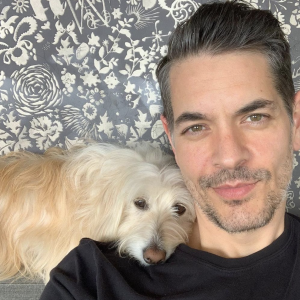
Robert Haussmann, CPDT-KA
Robert Haussmann is a Certified Professional Dog Trainer, Canine Behavior Consultant, and Co-founder of Dogboy NYC. He is licensed under the Certification Council for Professional Dog Trainers and has been working with dogs and advising their humans since 2003. With over 25 years of experience, he is an experienced trainer and focuses on puppy training, foundation training, basic manners, agility, behavior modification with an expertise in challenging behaviors such as separation anxiety, fear, and aggression. He founded Dogboy NYC in 2005 to help canine and human clients navigate the complex urban jungle of New York City.
Through creative, practical, and humane solutions, Robert specializes in helping dogs overcome behavior issues like fear, phobias, anxiety, and aggression. He advises clients on the best practices for helping their dogs thrive at home and beyond.
Since he was a child, Robert has had an inherent interest and deep connection with dogs. After college he contemplated a career with animals. Robert studied animal behavioral science with a strong focus on applied behavior analysis and operant conditioning to begin his education as a professional dog trainer. To this day, Robert is fascinated by the human-dog connection and continues to learn through professional and educational development.
Robert met his wife Kim in 2000. He quickly earned the nickname “Dogboy” through his ability to find, befriend, and safely return stray dogs to their owners and nearby shelters. When Robert and Kim began brainstorming business names in 2004, Dogboy NYC became the obvious right choice. They live in Brooklyn with their daughter and their fuzzy rescue dog Josie.
Training includes Puppy Training, Basic Manners, and Behavior Modification. He facilitates group classes such as Puppy Social Group, Basic Manners, Introduction to Agility, Tricks Class, and Introduction to Scent Work.
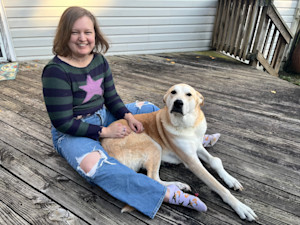
Savannah Admire
Savannah Admire is a writer and pet mom to two dogs and a cat. Under the name Savannah Cooper, she has published poetry in 40 different publications, as well as a poetry book, Mother Viper (2025). When she’s not writing, you can find her reading, taking photos, or volunteering as a content creator for her local community theatre. As a pets writer, she focuses on cat and dog behavior and pet parenthood. She currently lives in Western Maryland.
Related articles
![Man in park struggling to hold his Pitbull dog who is pulling on a leash]()
“How Do I Get My Dog to Stop Pulling on the Leash?”
Dog trainer Robert Haussmann’s tips for turning a stressful walk into a chill stroll.
![Three dogs on leashes meeting and sniffing each other on a walk on the summer grass with owners]()
How Do I Get My Shy Dog To Socialize?
Kinship Collective dog trainer Robert Haussmann’s tips for getting a shy pup to go from wallflower to social butterfly.
How to Train a Dog Not to Jump
Kinship Collective dog trainer Robert Haussmann’s pro tips for getting a hyped-up dog to chill out.
“How Can I Curb My Dog’s Squirrel Obsession?”
Dog trainer Robert Haussmann’s pro tips for walking a pup that wants to chase everything that moves.
